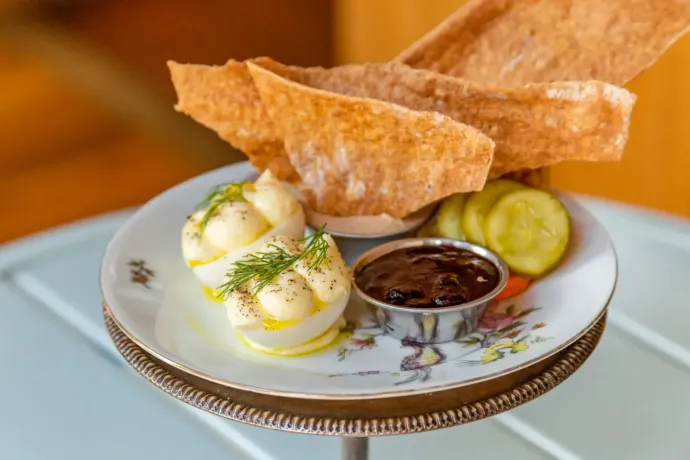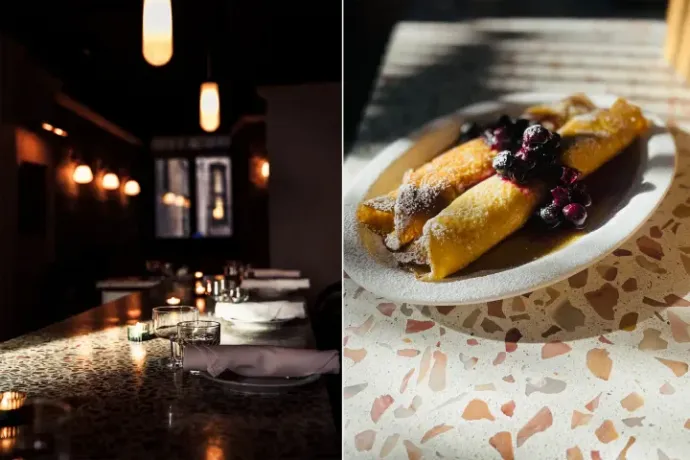
Broth with nokedli (Hungarian gnocchi-type dumplings) and dill. While these three are important staples of Hungarian cuisine, they almost never appear in the same dish in Hungary. Palacsinta (the Hungarian equivalent of the French crépes) served to look like a crumpled sheet of paper. Pogácsa (salty biscuits usually sprinkled with cheese) with a fried egg and cheese. Grízgaluska (semolina dumplings) as a main course.
All of the above are unusual combinations for us Hungarians and yet, they can be found on the menu at Agi's Counter in New York. Jeremy Salamon, the chef-owner of this increasingly popular restaurant is a second-generation Hungarian who is reimagining the dishes of his Hungarian Jewish immigrant grandmother, Ági. In 2022, the bistro was named one of Bon Appetit magazine's 50 Best Restaurants, and earlier this year Salamon was nominated for a James Beard Award in the category of Best Chef: New York State.
The central question for restaurants in Hungary has also been how Hungarian dishes can and should be cooked and served in 2024. There is no consensus on this here at home. Some believe it is only worth improving our traditional dishes in technological terms or by using better quality ingredients, while others are deconstructing and then rebuilding dishes like paprika potatoes and somlói galuska (a sponge cake dessert). And then there is the other extreme, where caviar and microgreens are added to each, otherwise conventionally prepared dish, which is supposed to make it elegant or modern.
What Salamon does is capture Hungarian food without the constraints of conformity and posturings that many chefs in Hungary struggle with. His ideas are so infinitely simple that it's often just the way it is served that makes a dish brilliant or a touch more modern.
The chef's first book, Second Generation – Hungarian and Jewish Classics Reimagined for the Modern Table, is set to be published in September, combining American, Hungarian and Jewish traditions with the most fashionable techniques, methods and styles with even more freedom and boldness than the restaurant's menu does.
His solutions may seem outrageous to the conservative Hungarian eye, and he is well aware of that. In his introduction to the recipe for paprika crab he admits that "this would be a big no-no in Hungary". He calls his “körözött” (a sandwich spread made from cottage cheese, ground paprika and seasonings) spicy cream cheese, his “madártej” (a vanilla custard-type dessert) is layered in a glass cup, he drizzles fermented honey over his lángos, his lecsó (a ratatouille-style main course) is a sauce served with roasted meat, and so on.
His approach would most likely provoke a flurry of indignation in most Hungarian households, but fortunately, he is far enough to feel no fear whatsoever.
And that's exactly why I asked him how he sees Hungarian cuisine, how he approaches a classic dish and how New Yorkers have received paprika chicken.
What made you decide to build a restaurant on the dishes of your Hungarian grandmother?
When I was in school and my friends asked what I had had for lunch or dinner, I'd say, yeah, I ate goulash or paprikash. I thought that was normal. So growing up, it was very much a normal thing for me to say and eat that. And I didn't really start thinking about Hungarian food as part of a much bigger picture, or as part of the cuisine in America until I was probably like 18 years old, 19. And I had read a couple of very old cookbooks that were about Hungarian cuisine. I mean very old, old Hungarian cuisine. And it was just very appealing to me, especially George Lang’s book. I had not seen Hungarian food written about or talked about like that ever. So I thought, well, if Hungarian food could be this, then what else could it be?

And that was how I decided to start exploring Hungarian food in different avenues, not just with the infusion of American cuisine, but also how a chef, a young chef in New York City, might cook it using the farmer's market and being influenced by all these different things that are happening here, how could Hungarian food look? So that's how it started.
What makes Hungarian food interesting for the American audience?
I think the way in which I am presenting it to people is very nostalgic for people like me who are second generation Hungarian-American. There's so many of them. I think there's this sense of, oh, I remember that, or I remember that smell in Grandma's kitchen, or I remember this dessert that was very specific to my childhood, so I think nostalgia is the appeal.
I think it's also comfort food. I think people want to feel comforted right now.
And I think that this food and the way in which I am presenting it makes it accessible and approachable, even though it's something that is not common. It's not Italian. It's not Asian. But I think that's also the thrill of it, it is something new. So there's multiple things at work.
And for other people who aren’t familiar with Hungarian food or haven’t heard about it, what is the appeal for them?
For example, I love when I serve my grandmother's palacsinta, which is accessible the world around. It's a crépe that is so versatile. And I've served it the way that my grandmother would make it: with cottage cheese or jam, perhaps with cinnamon or chocolate sauce. But I also present it in new ways with strawberries.
And when people eat it, their eyes get really big and they're like, oh, this is so delicious. I didn't know Hungarian cuisine could be like this. And then I know I'm doing what I said I would set out to do. People just see it in a different light. At first, folks are hesitant about it, and sometimes they say to me, oh, so I'm about to get heavy food and heavy sauces and it's all meat. And then when I present the food to them and their mind has changed, that's worth everything.
For example, we always have paprika chicken on our dinner menu. But I'm presenting it in a different way, which would be instead of a braised chicken, we take half a chicken and bone it, and then we press it so it gets really flat and really crispy. But I make a paprikash sauce and then ladle it over the top of it and then finish it with just very high quality paprika. I think that dish is also representative of this new concept of what a progressive kitchen can be, where it's the same thing in a sense, but reimagined.
The feedback is mostly positive. Of course, I have older Hungarians come in or older children of Hungarians that are looking for very authentic food. They want something very traditional. And they clearly did not do their research when they came into the restaurant. And they get upset. They're upset that they didn't get the goulash they were expecting.

I understand them, it makes sense to me. I understand the longing, the need, the desire for nostalgia, of wanting to be connected to the present while preserving their traditions. That’s important, but it’s also important to move forward. I think it’s also very much worth rethinking and reimagining these dishes, it’s not disrespecting the cuisine, which is something I’ve been accused of. If anything, it’s a way of preserving it, because
the younger generation wants to see it in a new light. And I think showing them what’s possible is not disrespectful. I think it’s a beautiful thing. I think it’s an evolution of cuisine, which is so natural.
And when you work on one of your grandmother’s dishes, how do you approach it?
So there's a good example. My grandmother used to make these dumplings that were made out of semolina. And she would serve them with whatever she liked. They were huge, and she would serve them with the paprikash, or next to Eggplant Parmesan, just kind of whatever she was feeling. So I took her recipe for that, which was very hard to read. So I took it and adapted it so it could be made in a restaurant too. I simplified it, figured out a way to produce it in large quantities at the restaurant so I could teach it to my cooks. It took a long time, and I tried to introduce these dumplings into new formats.
In the springtime, I'll make a soup with it, with fresh radishes. The interesting thing about this process is that while I am simplifying, there’s actually a lot of work behind it.
So I feel like the radish soup was a good example of how it can be simple, elegant, but still incorporating my grandmother's technique or her idea at the core of it.
Are there any Hungarian foods your grandmother didn’t make that you only discovered as an adult?
My grandmother never made lángos, I first tried it in Hungary, and that was a big deal for me. I was like, my God, this is so delicious. Why don't more people eat it here in America? Especially because it's fried dough, which is very American. So being able to play with that was very exciting.
And the other one, which I can never pronounce well – körözött? I first ate this at a relative's house in Budapest, and it reminded me of an American dish, cream cheese pimento, which I used to eat a lot during summer holidays in the south. So it also brought back memories, but American ones. I could have eaten a whole bowl of it as it was, with a spoon. I didn't know if it was that fantastic, or if he just made it special, but it was a revelation. I then developed a version of the recipe for the cookbook, trying to bring it closer to the American palate. It was a process similar to trying to get a two-year-old to like a vegetable. It turned out so well that I stuffed it into squash blossoms and fried it in oil.
Are there any ingredients you don't use because they're not available in the US? I didn't see poppy seeds in the book, even though we eat poppy seeds all the time in Hungary.
The truth is, I'm not a big fan of poppy seeds, which is weird because it goes against everything in my blood. They have a very specific flavor, so I only like poppy seeds in a few formats. I like it best in Bejgli (Bezsli? Am I pronouncing it right?), we had it on the menu around Christmas and were going to put it in the book, but it's very complicated to make, and it's hard to learn.
How do you find new ideas, or new Hungarian ideas that are yet unknown to you?
In the last three years we have developed a lot of basic dishes that people like. Now they come in and say palacsinta and pogácsa as if they've known them since birth. The palacsinta changes on a seasonal basis, and the nokedli soup always returns for fall and winter. These are things I wouldn't want to change, because our customers are counting on them. I like the consistency, that they can come back day after day and know they'll find the same things which gives them a sense of security. That being said, I'm of course looking for new inspirations, but I'm also interested in how to approach a dish that's already been reimagined from a new angle.

Hungarian and Jewish cuisine are intertwined in the book. Where do you see the connection?
I cannot look at Hungarian culture without Jewish influences, because that's how I was brought up. All my grandparents were Jewish and Holocaust survivors. That's very important to me, and it's a significant narrative for the restaurant, but not everyone sees it that way. The book also includes many Jewish dishes.
When you were in Hungary a few years ago, how did you see the evolution of local gastronomy?
In some ways, what I am doing is similar to what some Hungarian chefs are working towards. Only my food looks different, and obviously tastes different, because my starting point is the American world – and that's fine, it should be different. I was very impressed with the way Hungarian restaurants are engaging with Hungarian cuisine, how they take pride in their food, and it gave me a sense of pride too. Hungarians generally want to eat traditional food, and that's okay, they are fighting to preserve nostalgia, and that's a nice idea. Nevertheless, I ate at a few brave places where I felt they had found the balance between old and new, and that was exciting.
For more quick, accurate and impartial news from and about Hungary, subscribe to the Telex English newsletter!